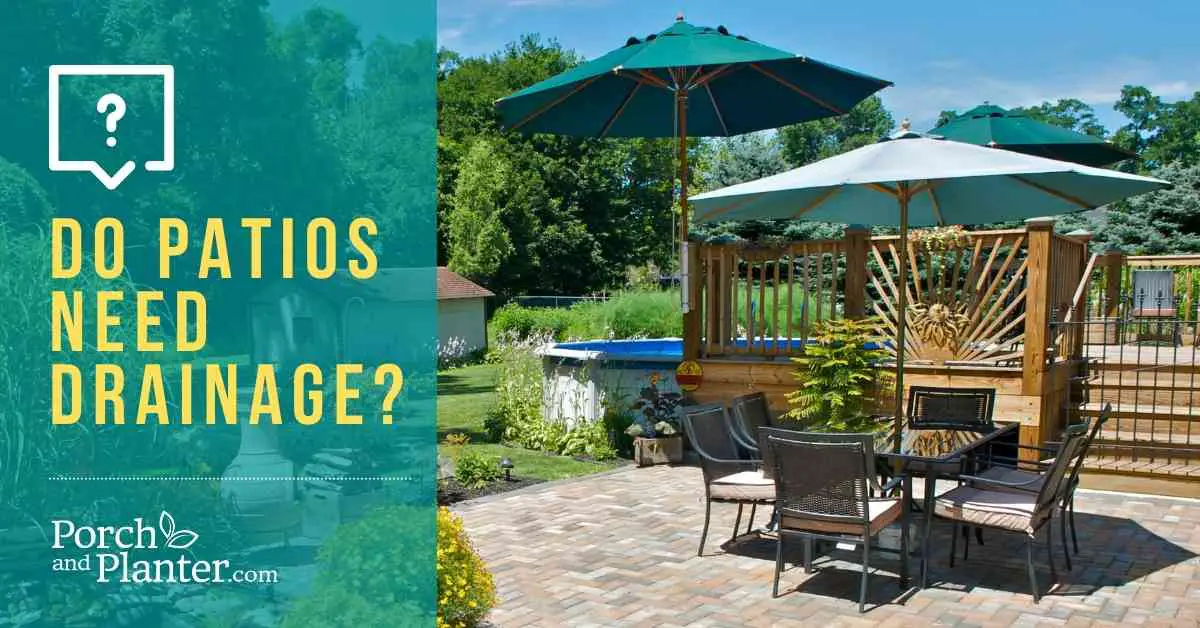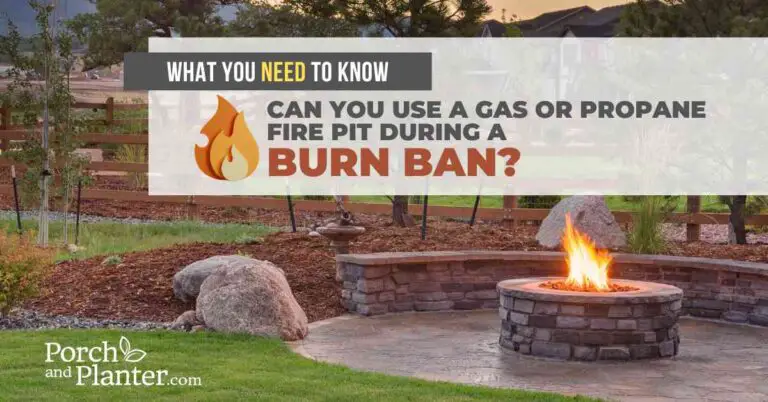Do Patios Need Drainage? [ANSWERED]

There’s a lot to consider when you’re putting in a patio. Colors, materials, dimensions, furniture… it can be overwhelming. With all the decisions you have to make when putting in a patio, you don’t want to overlook one of the most important considerations – does my patio need drainage?
Do Patios Need Drainage?
Yes, patios do need some form of drainage so that they do not accumulate standing water which can lead to the growth of mildews and mold. There are a variety of different drainage techniques you can use for patios, including french drains, perimeter drains, and channel drains. The type of patio you’re putting in will determine what type of drainage you put in.
Do Slab Patios Need Drainage?
Yes, slab patios definitely need drainage. Without proper drainage and a slight slope, there is nowhere for the water to flow with a concrete patio slab, leaving it to pool. We recommend considering a combination of a French drain or perimeter drain and a channel drain.
Do Paver Patios Need Drainage?
Yes, most paver patios will require drainage. Despite the fact that water will flow down between the pavers into the ground, that might not be enough to provide efficient drainage. Paver patios should be sloped slightly, and usually, a French drain or perimeter drain is installed to help further move water away from the patio. Channel drains are also particularly easy to install with pavers, making them a great choice for diverting water as well.
Do Flagstone Patios Need Drainage?
Yes, most flagstone patios will require drainage. Without it, there is nowhere for the water to flow, making standing water likely. The same drainage techniques that work for paver patios will also work for flagstone patios.
Do Tiled Patios Need Drainage?
Yes, most tiled patios require some form of drainage. Tile requires a slight slope to allow water to flow, and this is best achieved with a French drain or perimeter drain system.
What is a French Drain?
A french drain is a channel in the ground with a perforated pipe covered in gravel with a layer of fabric and topped with soil or sand. The water drains down through the top layers of soil, fabric, and gravel into the perforations in the pipe, which directs the water away to a safe drainage area.
What is a Perimeter Drain?
A perimeter drain is a channel in the ground with a perforated pipe wrapped in a fabric or mesh sock to keep soil out of the pipe. This pipe is then surrounded by gravel and covered in soil. Perimeter drainage systems surround the perimeter of a home and direct water away from it to keep it from causing damage.
What Is the Difference Between a French Drain and a Perimeter Drain?
French drains and perimeter drains are very similar, but they mostly differ in how they prevent dirt from getting into the pipe that takes the water away from the area being drained. The French drain system relies on gravel and a layer of fabric under the topsoil to keep out the dirt, while the perimeter drainage system uses a fabric or mesh sock around the pipe itself.
What Is a Channel Drain?
A channel drain is a drainage system inserted into a trench with a grate over the top. Water flows down through the grates and into the channel, which carries it away from your patio. Channel drains come in a variety of sizes, materials, and colors, so it’s easy to find ones that will go with your patio.
Should You Slope Your Patio for Drainage?
Yes, you should slope your patio to create drainage. You should slope the patio a quarter of an inch per foot along the length of the patio. This helps water drain off of the patio and away from areas where it can cause damage.
Where Should You Install Your Patio Drainage System?
The best place to install your drainage system is where water naturally flows to. For example, if you have a patio with a hill behind it, the best place for your drainage system is on the downhill side. If your patio slopes towards your house or towards a pool, you’ll want to add some form of drainage such as French drains or channel drains to divert the water away from those.
Where Do Patio Drains Divert the Water?
Many patio drains divert the water to a safe area away from your house and patio, such as a dry well or pit, or into an area with garden beds. This will prevent any pooling of water that might damage your foundation or get into the house’s plumbing system.
Common Patio Drainage Problems
Some common problems that can arise with patio drainage include standing water, vegetation damage, and slope failure, all of which are definitely things you want to avoid.
- Standing water – Slab patios and tiled patios without any form of drainage will accumulate standing water, which is not only an eyesore but also can be a breeding ground for mold, mildew, moss, fungi, algae, insects, and bacteria.
- Vegetation damage – Without proper grading or drainage, your patio can actually begin to harm surrounding vegetation by creating too much moisture around the roots. This leads to root rot.
- Slope failure – Without proper grading or drainage, water can collect around your patio and under the patio itself causing the soil to become too heavy for the slope you have created. This leads to slope failure, which leads to erosion of both your patio stones and surrounding vegetation as well as damage your home.
Patio Drainage Tips
Drainage can vary depending on your needs or style preference. French drains are usually installed in the ground with perforated pipes that allow water to drain away from the patio area. A perimeter drain is similar but it’s set up around all four sides of the patio instead of just one side like a french drain would be. Another option for patios is installing an underground rainwater collection system which will collect runoff water into cisterns located beneath or near your patio before releasing it back into the ground naturally via gravity flow (or by pumping).
In addition to drainage, patios should be sloped slightly downwards away from the home’s foundation. The best direction for this slope is away from your house and towards a flower bed or other area where you can enjoy the water while it sinks into the soil. This will ensure that no standing water accumulates on the patio while still allowing water to drain away from your home.
If you wish to use a patio in low-traffic areas, a channel or perimeter drain may not be necessary. In these cases, it is best to slope the ground downward towards a flowerbed so that water can flow through natural pathways and prevent standing water from accumulating on the surface of your patio.
In conclusion, the variety of patio drainage systems available means there is a system to suit any type or size of property. Understanding which type you need will help make sure that your patios are safe for use and free from standing water while still allowing water to drain away naturally.





![Are Pavers Safe for a Fire Pit? [ANSWERED]](https://porchandplanter.com/wp-content/uploads/2021/09/Are-Pavers-Safe-for-a-Fire-Pit-768x402.jpg)

